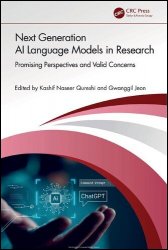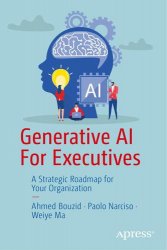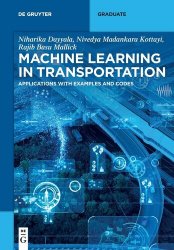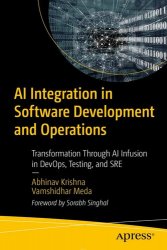 Название: Next Generation AI Language Models in Research: Promising Perspectives and Valid Concerns
Название: Next Generation AI Language Models in Research: Promising Perspectives and Valid ConcernsАвтор: Kashif Naseer Qureshi, Gwanggil Jeon
Издательство: CRC Press
Год: 2025
Страниц: 349
Язык: английский
Формат: pdf (true), epub
Размер: 26.8 MB
In this comprehensive and cutting-edge volume, Qureshi and Jeon bring together experts from around the world to explore the potential of Artificial Intelligence (AI) models in research and discuss the potential benefits and the concerns and challenges that the rapid development of this field has raised.
The international chapter contributor group provides a wealth of technical information on different aspects of AI, including key aspects of AI, Deep Learning and Machine Learning models for AI, natural language processing (NLP) and computer vision, reinforcement learning, ethics and responsibilities, security, practical implementation, and future directions. The contents are balanced in terms of theory, methodologies, and technical aspects, and contributors provide case studies to clearly illustrate the concepts and technical discussions throughout. Readers will gain valuable insights into how AI can revolutionize their work in fields including data analytics and pattern identification, healthcare research, social science research, and more, and improve their technical skills, problem-solving abilities, and evidence-based decision-making. Additionally, they will be cognizant of the limitations and challenges, the ethical implications, and security concerns related to language models, which will enable them to make more informed choices regarding their implementation.
In today’s hyperconnected world, where technology permeates every aspect of our lives, Artificial Intelligence (AI) has emerged as a transformative force. In the landscape of Artificial Intelligence, the emergence of next-generation language models represents a significant milestone. These models, often leveraging deep learning architectures, have showcased remarkable capabilities in understanding, generating, and manipulating human language. Their applications span across various domains, from aiding in natural language understanding and generation tasks to facilitating human-computer interactions and automating repetitive processes. Next Generation AI Language Models in Research: Promising Perspectives and Valid Concerns explores the forefront of this technological advancement, offering a comprehensive exploration of both the potential benefits and the associated challenges. As we embark on this journey of innovation, it becomes imperative to critically examine the promises these models hold and the concerns they raise.
The editors of this book, with their deep expertise and extensive experience in the field of AI, provide valuable insights into the unique risks associated with AI. At the heart of this book lies an acknowledgment of the transformative potential of next-generation AI language models. They have revolutionized the way we interact with technology, enabling more intuitive and efficient communication between humans and machines.
Language Models (LM) have been adopted in various fields to generate the human language. These computational models have capabilities to predict the word sequence and generate text. The Language Models achieved significant improvements and trained on massive amounts of text data with high accuracy. These models are based on transformer architectures to tackle the long-range dependencies from languages. The large language models have made significant advancements and trained on massive amounts of data to generate human-like responses such as Generative Pre-trained Transformer (GPT-3). These models use transformer architecture and improve the language models’ ability to handle the natural language texts. The transformer architecture is based on self-attention method and makes better relationship between sentences, words, and their positions. This architecture also used the pre-trained model by using large datasets and performing a wide range of language tasks. One of the well-known examples is Bidirectional Encoder Representation (BERT) which is pre-trained by using Natural Language Processing (NLP) tasks like classification and entity recognition. These models are also capable of learning complex patterns, semantic relationship, and linguistic nuances. The latest ChatGPT uses OpenAI and is trained on internet-sourced data such as books, articles, and websites. The latest version, GPT-4, has more advanced features like visual information and generates responses with more rich information and content.
This book is an invaluable resource for undergraduate and graduate students who want to understand AI models, recent trends in the area, and technical and ethical aspects of AI. Companies involved in AI development or implementing AI in various fields will also benefit from the book’s discussions on both the technical and ethical aspects of this rapidly growing field.
Скачать Next Generation AI Language Models in Research: Promising Perspectives and Valid Concerns
[related-news] [/related-news]
Комментарии 0
Комментариев пока нет. Стань первым!















